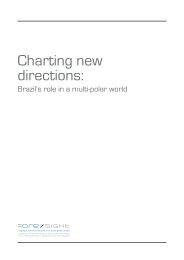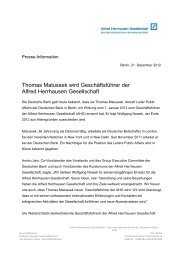India's role in a multi-polar world - Alfred Herrhausen Gesellschaft
India's role in a multi-polar world - Alfred Herrhausen Gesellschaft
India's role in a multi-polar world - Alfred Herrhausen Gesellschaft
Create successful ePaper yourself
Turn your PDF publications into a flip-book with our unique Google optimized e-Paper software.
36<br />
Through a billion voices: India’s <strong>role</strong> <strong>in</strong> a <strong>multi</strong>-<strong>polar</strong> <strong>world</strong><br />
flow<strong>in</strong>g from the surplus countries to the deficit<br />
countries, which many believe has been one of the<br />
causes of the recent f<strong>in</strong>ancial crisis. As the crisis<br />
deepened, the major deficit countries saw domestic<br />
sav<strong>in</strong>gs <strong>in</strong>crease while their current account deficits<br />
decl<strong>in</strong>ed. Meanwhile, <strong>in</strong> the major surplus countries<br />
the current account surpluses also decl<strong>in</strong>ed.<br />
It is supposed by many that global imbalances<br />
will soon be cured. However, this is a premature<br />
assessment because the fundamental drivers of<br />
this era of globalisation have not changed one iota,<br />
despite the destructive forces which they unleashed<br />
to br<strong>in</strong>g about the crisis.<br />
Even a casual glance at the countries on oppos<strong>in</strong>g<br />
sides of the imbalances reveals a pattern to this new<br />
wave of global labour division. On the deficit side,<br />
we have the US, the UK and Australia, all of which<br />
have adopted the Anglo-Saxon model of capitalism<br />
and have strong f<strong>in</strong>ancial sectors. The surplus side<br />
is more diverse, but we can still discern a pattern.<br />
It is comprised of three groups of countries: the old<br />
manufactur<strong>in</strong>g giants, namely, Germany and Japan,<br />
Whilst the American f<strong>in</strong>ancial market<br />
may be too fluid, the f<strong>in</strong>ancial markets<br />
<strong>in</strong> the surplus countries are too static<br />
the newly emerged “<strong>world</strong> factories”, especially<br />
Ch<strong>in</strong>a, and oil exporters.<br />
Here the key to understand<strong>in</strong>g the imbalances is<br />
to th<strong>in</strong>k about f<strong>in</strong>ancial services as a tradable good.<br />
Traditional economic theory does not recognise them<br />
as such, thus it cannot be used to expla<strong>in</strong> current<br />
account imbalances. This is because a surplus country<br />
experienc<strong>in</strong>g an <strong>in</strong>crease <strong>in</strong> wealth would import<br />
more until its current account surplus is depleted.<br />
Meanwhile, a deficit country faced with high <strong>in</strong>terest<br />
rates would cut borrow<strong>in</strong>gs <strong>in</strong> order to rebalance its<br />
current account.<br />
Thus, if we treat f<strong>in</strong>ancial services as a tradable<br />
Grow<strong>in</strong>g pa<strong>in</strong>s: global adjustment architecture | Yang Yao<br />
good, it becomes easier to expla<strong>in</strong> global imbalances.<br />
It is not a co<strong>in</strong>cidence that all of the surplus countries<br />
do not have highly developed f<strong>in</strong>ancial markets. They<br />
generally specialise <strong>in</strong> either manufactur<strong>in</strong>g or <strong>in</strong> oil<br />
export<strong>in</strong>g. Like other activities, f<strong>in</strong>ance is concentrated<br />
<strong>in</strong> places where efficiency can be maximised. It is<br />
therefore of little surprise that the “manufactur<strong>in</strong>g”<br />
of f<strong>in</strong>ance is concentrated <strong>in</strong> New York and London.<br />
As a result, “hard-earned” money flows from the<br />
surplus countries to the deficit countries. Here<br />
“money” is the <strong>in</strong>put of the f<strong>in</strong>ancial companies <strong>in</strong><br />
New York and London, just like raw materials bought<br />
by any manufactur<strong>in</strong>g company.<br />
The f<strong>in</strong>ancial markets <strong>in</strong> the surplus countries are<br />
<strong>in</strong>capable of channel<strong>in</strong>g <strong>in</strong>come earned from exports<br />
towards domestic <strong>in</strong>vestment or consumption,<br />
so those countries have to seek the assistance of<br />
f<strong>in</strong>ancial service firms <strong>in</strong> New York and London to<br />
help <strong>in</strong>vest their surpluses. This observation has an<br />
ironic implication when viewed <strong>in</strong> the context of the<br />
debate over the cause of the global f<strong>in</strong>ancial crisis,<br />
where blame is often laid squarely on the door of<br />
the American f<strong>in</strong>ancial market. Whilst the American<br />
f<strong>in</strong>ancial market may be too fluid, the f<strong>in</strong>ancial<br />
markets <strong>in</strong> the surplus countries are too static.<br />
The large <strong>in</strong>flux of money creates a wealth effect<br />
that <strong>in</strong>creases current consumption <strong>in</strong> the recipient<br />
countries, ultimately creat<strong>in</strong>g deficits <strong>in</strong> their current<br />
accounts.<br />
The pa<strong>in</strong> of downward adjustment<br />
For many, the f<strong>in</strong>ancial crisis demonstrates that<br />
the current pattern of global specialisation is<br />
unsusta<strong>in</strong>able. However, view<strong>in</strong>g it with the reason<strong>in</strong>g<br />
presented above, one realises that the issue is not<br />
one of susta<strong>in</strong>ability, but one of adjustment. In this<br />
case, two factors, both relat<strong>in</strong>g to economies of<br />
scale, require pa<strong>in</strong>ful adjustments <strong>in</strong> most countries:<br />
(1) the concentration of manufactur<strong>in</strong>g <strong>in</strong> a few<br />
countries; and (2) the concentration of f<strong>in</strong>ance among<br />
a small section of the population <strong>in</strong> f<strong>in</strong>ancially strong<br />
countries.








